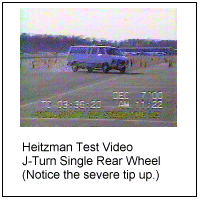
|
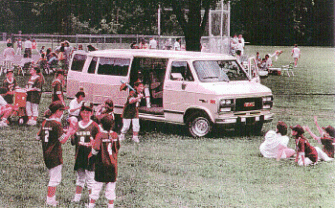
15-Passenger
Vans: A group of church women on a shopping trip in Texas…a 6-year-old boy en route to his swimming class in South Carolina…a track team from Prairie View A&M University…another from DePaul University…the Wisconsin-Oshkosh swim team… the Kenyon College swim team... a group of Long Island high school students on their way to see the Grand Canyon… All had one thing in common: they were riding in 15-passenger vans that crashed with all too tragic – and common – results. Many were killed, many others maimed and disfigured in what are among the most lethal vehicles on the road today. For one thing, the vans, so popular for transporting pre-school, school-age, college and church groups, are involved in rollover crashes more often than all other vehicles. The National Transportation Safety Board (NTSB) calculates that the vans overturn more than half the time they are involved in single-vehicle crashes, compared to 33 percent of the time for other vehicles. Surprisingly, 81 percent of all fatalities in 15-passenger van crashes occur in just such single vehicle rollovers. The death toll can be measured by the stark data in the Fatality Analysis Reporting System (FARS) :
|
Attorneys of
Record Ben
Hogan Richard
Denney Ted
Leopold C. Tab
Turner David
Perry |
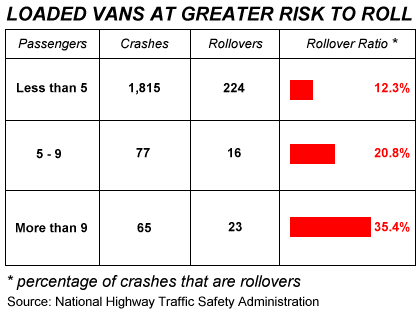 Marketing Death Because they are inexpensive compared to school buses, vans have grown popular for transporting children, the elderly, sports teams and other groups. All three manufacturers of 15-seat vans marketed their vehicles for just such use. DaimlerChrysler stated that its van “can hold more than your daughter’s closet and carry as many as 15 happy campers.” General Motors has portrayed its van surrounded by a young ball team. By 1999, the National
Transportation Safety Board (NTSB) was calling attention to what it
termed “a disturbing trend in pupil transportation,” warning that school
districts, day care centers, Head Start programs, contract
transportation companies and others were hauling children in vans that
“meet the federal definition of a bus but not the federal occupant crash
protection standards of school buses.” (See below.)
A Few Among Many
 The More, the Deadlier As the death toll mounted, NHTSA analyzed 1,957 crashes that involved 15-passenger vans and discovered that the more passengers the van was carrying, the more likely it was to overturn:
Overall, the vans were three
times more likely to roll over in a crash when loaded with 10 or more
passengers than when they carried fewer than five.
Why the Carnage? A major problem is that the 15-passenger van has a high center of gravity. That center shifts even higher and rearward as more occupants board. The rearward shift gives the van a propensity to “fishtail” and the upward shift increases its likelihood of overturning. The combination of lateral slide of the rear tires – fishtailing – and the “top-heavy” design compound the risk of rollover. Dangerous stability problems, not noticeable to average drivers, become all too apparent in emergency steering situations, such as swerving to avoid an obstacle or a sudden tire failure at highway speed. A van that is fishtailing is out of control. The more heavily loaded the van, the greater the gravity shift and the more likely it is to overturn, with tragic consequences. Once the van does overturn, its occupants are exposed to even greater hazards than those of most vehicles:
Such shortcomings make the
15-passenger van literally a death trap on wheels, a trap merely
awaiting an opportunity to spring on unwary passengers and
driver. A History of Avoidance How did a passenger vehicle marketed to carry groups of children, the elderly and other vulnerable populations become such an open threat to their lives? The answers are rooted in the vans’ history. In the early 1970s, first Dodge, then Ford sought to accommodate emerging demand for a vehicle that could carry small groups of passengers. Instead of creating a new vehicle, they chose to modify existing cargo vans simply by making the body longer and installing seats for 15 passengers, without lengthening the wheel base. (Dodge ceased manufacturing its 15-passenger vans in June 2002, but many remain on the road.) Ford chose to ignore its own engineers’ recommendations. Records show engineers recognized early the need to extend the wheel base and add dual rear wheels to prevent fishtailing. Videotaped tests demonstrate that using dual rear wheels would significantly reduce side sway and the tendency to “slide out.” It would also provide redundancy if a tire fails. The engineers’ recommendations were rejected because of the projected costs – an estimated $315 per vehicle – and production delays. As a result, the Ford E-350 SCW, which now controls most of the market, has remained essentially unchanged since 1979. General Motors entered the 15-passenger market late, around 1990, by expanding its 12-passenger van to 15 passengers. Although GM did lengthen the vehicle’s wheel base, it did not bother to conduct any “side pull” tests on the vans, despite having performed such tests on other vehicles since the 1960s and despite advising NHTSA in 1973 that the tests were the “best approach to determine rollover resistance.” In fact, GM has known since the early 1980s that vans experience more rollovers and more occupant ejections in crashes, yet the auto maker has conducted no stability test of any kind on its 15-passenger GMC van.
 The Regulatory Vacuum Under existing federal requirements, dealers are not allowed to sell a vehicle as a school bus unless it meets federal school bus requirements – including increased standards for structural integrity and safety packaging, and flashing lights and stop arms to alert oncoming traffic. The 15-passenger vans are not deemed school buses, and since the federal regulations address the sale of such vehicles, not their use, neither manufacturers nor government regulators have given them the safety attention they deserve, even though they are in fact often used to transport schoolchildren, among others. One example of the
regulatory vacuum in which such vans operate: sports utility
vehicles (SUVs) also have a propensity to overturn in crashes.
SUVs with a 110-inch wheel base, however, are required to carry rollover
warning labels; vans are not. States Leap Into the Breach Faced with the escalating death toll and federal inaction, state and local authorities have sought to fill the regulatory vacuum. Predictably, their requirements vary widely, and it appears that the younger the children being transported, the fewer the safety protections that apply. A 1999 survey, responded to by 32 states, revealed that:
You don’t have to look further than four fatal van crashes that the NTSB investigated in 1998-99 to see that the vans were being used for a purpose that was permitted by the governing state or local regulations: FloridaA few states are now stepping in to mandate that all school-related transportation be done with buses that meet the federal occupant-protection standards for school buses. South Carolina led the way when it enacted “Jacob’s Law” in 2000, named after the six-year-old killed in a van on his way to swimming class in 1994 in Columbia, SC. The new law mandates that any entity transporting students to or from schools or school-related activities, from child care and pre-primary through secondary schools, must use a bus that meets all federal safety standards for school buses. Kansas has enacted a similar law, to take effect in July 2004. Nevertheless, little has changed since the NTSB published this lament in 1999: “While most states require that children can only be transported to and from school on buses meeting federal school bus crash-worthiness standards, some states either allow or do not prohibit the use of nonconforming buses for school-related activities, Head Start programs, child care facilities, and ‘for hire’ transport, despite federal guidelines to the contrary…. When states and various school systems allow children to be transported in vehicles not meeting federal school bus construction standards, the federal intent of protecting school children is undermined.”
Despite the good "intentions" of federal guidelines, they have been ineffective in saving the lives of van occupants because they lack enforcement muscle. Nevertheless, the government's safety regulators at NHTSA continued ignoring the problems in the face of the mounting death toll, proffering little more than advice that drivers of the vans be careful. In 1999, the NTSB continued to shift the burden to the states, recommending that all 50 states require that all vehicles meet the national school bus structural standards (see below) if they carry more than 10 passengers and transport children to and from school and school-related activities, including Head Start programs and day care centers, but it did not recommend imposing a single national safety standard. Between 1999 and 2001, GuideOne Insurance policyholders filed claims totaling $4.3 million for five crashes involving 15-passenger vans. The crashes had caused 11 deaths and 20 serious injuries. GuideOne responded with a warning of its own to its customers: “More important is the impact that these accidents had on the health and vitality of the ministries and people involved. For these reasons, GuideOne believes that 15-passenger vans are inherently unsafe. We highly encourage all policyholders to strongly consider other transportation options.” On April 9, 2001, NHTSA added its advice as well. It issued a “cautionary warning” to users of 15-passenger vans that they faced an increased risk of rollover. It said that “it is important that these vans be operated by experienced drivers” and that passengers be required to buckle up to reduce the risk of ejection and serious injury or death (80 percent of those killed in 15-passenger van rollovers in 2000 were not buckled in). After several more highly publicized 15-passenger van crashes in 2001, NHTSA simply re-issued its ineffective consumer advisory a year later. Advice turned into action only in November 2002. On November 1, 2002, the NTSB wrote to both Ford and General Motors that it was recommending that 15-passenger vans be included in current rule-making activities, including testing of their ability to resist rollover. The NTSB told the auto makers: “Although NHTSA has initiated rule-making activities concerning vehicle rollovers, established a vehicle rollover resistance rating system, and is currently examining dynamic testing procedures, these programs do not extend to 15-passenger vans. Given their high rate of rollover involvement in single-vehicle accidents, particularly under fully loaded conditions for which they are designed and are being used, the Safety Board believes that 15-passenger vans should be included in dynamic testing and proposed rollover resistance ratings for this class of vehicle.” (View letter... requires Adobe Acrobat Reader)Four days later, on November 4, 2002, the NHTSA finally proposed establishing a new school bus category for safety regulation, the “multifunction school activity bus,” defined as any school bus of 15,000 pounds or less sold for purposes other than transportation between home and school for students from kindergarten through Grade 12. It said it was doing so “to provide schools, day care centers and other institutions with a safer alternative to 15-passenger vans.” Under the proposed NHTSA rules, such van-buses would be exempt from the traffic control requirements imposed on regular school buses, such as emergency signaling and “stop” arms to protect children boarding and leaving buses. |
| such maneuvers, as well as
offer the safety redundancy of an extra tire on each side so that sudden
failure of one tire is less likely to cause loss of
control.
 Widening the vehicle and/or reducing its height: These modifications would lower the center of gravity and further improve stability and resistance to rollovers. |
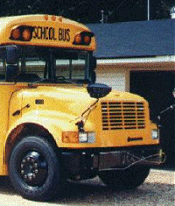 |
Imposing school bus structural standards: All buses must
meet federal standards, but since 1974 school buses have had to meet
additional structural standards expressly intended to protect occupants
in crashes. These include specifications for the joint strength of
body panels, roof rollover bars, and closely spaced, high-backed padded
seating. By law, school buses must also have strong steel side
beams and thick sheets of steel on both sides of the frame. These
protections should be extended to occupants of 15-passenger vans.
Equipping them with laminated side windows: |
| Laminated glass is far less
likely to shatter in a crash than tempered glass and therefore it is
more likely to prevent passengers from being ejected from the vehicle in
a crash, yet it is not used in the side windows of 15-passenger
vans.
During the 1980s, laminated glass was used for the side windows of many vehicles, even though tempered glass was less expensive. The reason was purely cosmetic: tinted windows had become popular and the laminate could be tinted. When manufacturers learned how to tint tempered glass, they switched back to the less expensive – but more hazardous – glass for side windows, at least until demand shifted yet again, this time in Europe as an anti-theft measure, because laminated glass is harder for thieves to break through. The NHTSA has been urged repeatedly for two decades to require laminated glass in side windows, but auto industry opposition has kept such a requirement off the books. One industry argument: that laminated glass causes “glass collar” injuries when penetrated. As glass consultant Herb Yudenfriend noted in a 1997 paper published by the Society of Automotive Engineers, such claims fail to mention the “ejection deaths and injuries that were not prevented by shattered tempered glass.” (Emphasis added.) Providing emergency exits: Vans do not have as many emergency exits as school buses and, unlike school buses, their rear doors are typically blocked by the back seat. Equipping them with safety signaling: Again unlike school buses, vans are not equipped with flashing lights or “stop” arms to control traffic when they pick up or disembark children or other at-risk riders.
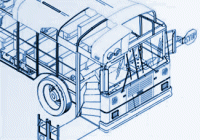 Requiring a commercial drivers’ license: A commercial drivers’ license (CDL) is currently required only for transporting 16 or more passengers. Obtaining a CDL requires specialized knowledge and skills testing. The chassis of small school buses is similar to that of 15-passenger vans, and thus small school buses may have similar rollover tendencies. All states require that drivers of small school buses have a CDL, but no such requirement applies to the drivers of vans designed to carry 15 or fewer passengers. It should. Meanwhile, little has changed since 1999, when the NTSB concluded with typical understatement: “State laws…do not provide uniform safety. Further, the lack of Federal and State legislation regarding Head Start and day care transportation allows for situations in which students may be transported in a vehicle that does not provide the maximum available protection during accidents.”Without nationwide regulation that truly addresses safe vehicle performance and occupant protection, the carnage will continue. |
|
|

